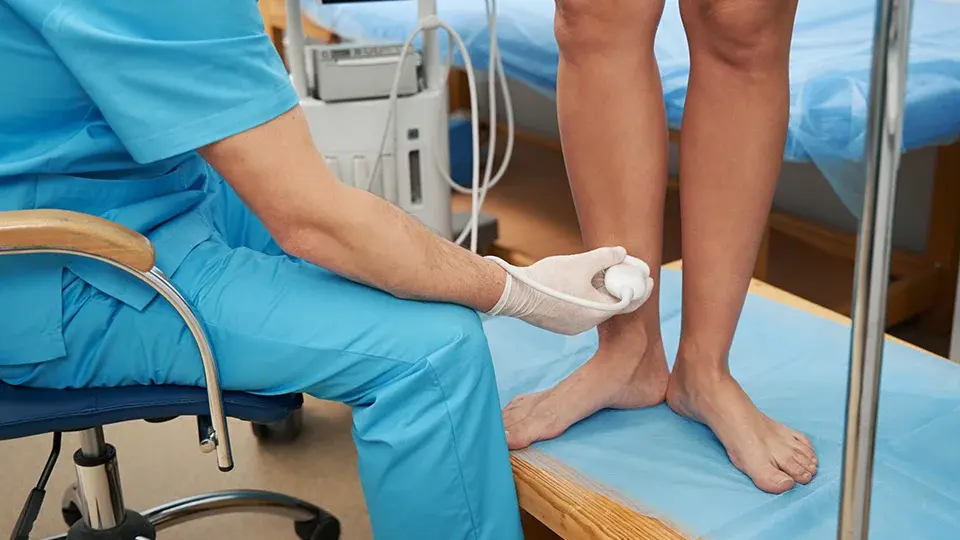Diagnosis of Varicose Veins
Diagnosing Varicose Veins
At Veins and Foot Clinic in Chennai, we prioritize early diagnosis of varicose veins. This empowers patients to manage the condition effectively and prevent potential complications. Here’s a breakdown of the diagnostic process:


Varicose Vein Symptoms and Signs
Varicose veins often announce their presence through distinct symptoms. Be mindful of:
Visible, bulging veins on the legs: These veins may appear twisted, rope-like, and blue, purple, or red in color. Spiderweb-like patterns can also develop.
Aching or heavy feeling in the legs: This discomfort is particularly common after prolonged standing or sitting and can worsen throughout the day.
Fatigue: A general sense of tiredness in the legs can be a sign of compromised circulation due to varicose veins.
Itching around the veins: This can be a persistent and bothersome symptom, especially at night, and can lead to skin irritation if scratched.
Swelling in the ankles: This is often noticeable after extended periods of standing or sitting and can improve with leg elevation.
Skin discoloration near the affected veins: A brownish or reddish tint near the varicose veins can indicate long-term damage caused by the condition.
If you experience any of these symptoms, consulting a qualified vascular specialist is recommended. Early intervention can prevent the progression of varicose veins and potential complications.
Physical Examination: A Focused Approach
During a physical exam, the doctor will likely take a comprehensive approach:
Medical and Family History: The doctor will inquire about your medical history and any family history of varicose veins. This can provide valuable clues about your risk factors.
Visual Inspection: The doctor will visually examine your legs for varicose veins, assessing their size, location, and the presence of any swelling or skin changes.
Palpation: Feeling your legs allows the doctor to assess for tenderness or unusual pulsation in the veins.
Cough Test: This simple test involves coughing while the doctor observes your legs. If the varicose veins become more prominent with coughing, it can indicate valve dysfunction.
Imaging Tests: Confirming the Diagnosis
While a physical exam can often be sufficient for diagnosing varicose veins, imaging tests might be recommended for additional confirmation or to gather a more detailed picture of the underlying issues:
Doppler Ultrasound: This painless test utilizes sound waves to create images of the veins. It allows doctors to assess blood flow within the veins, identify any blockages or valve problems, and determine the direction of blood flow.
Venography (Less Common): This X-ray procedure involves injecting a contrast dye into the veins to visualize their structure and blood flow patterns. While previously a more common diagnostic tool, the availability of non-invasive ultrasound has reduced its use.
The Importance of Early Diagnosis
Early diagnosis of varicose veins is crucial for preventing complications that can significantly impact your quality of life. These complications include:
Skin Ulcers: Chronic venous insufficiency, a condition where varicose veins damage the circulatory system in the legs, can lead to the development of painful skin ulcers.
Blood Clots (Deep Vein Thrombosis): Varicose veins increase the risk of blood clots forming in the deep veins of the legs (DVT). These clots can potentially break loose and travel to the lungs, posing a life-threatening risk.
Chronic Leg Pain: Unmanaged varicose veins can lead to persistent and debilitating leg pain that can significantly impact your daily activities.
Don’t let vein issues affect your life.
Book a call with us
Seeking Professional Help
If you suspect varicose veins, prompt consultation with a qualified vascular specialist at Veins and Foot Clinic in Chennai is crucial. They can provide a comprehensive diagnosis, discuss personalized treatment options, and create a plan to effectively manage your varicose veins and improve your overall leg health. Remember, early intervention is key to preventing complications and ensuring a better quality of life.
Conditions We Treat
- Varicose veins
- Superficial Venous Thrombosis Phlebitis
- Thread / spider veins
- Swollen leg
- Deep vein thrombosis (DVT)
- May turners syndrome
- Varicose veins in pregnancy
- Varicose veins in obese patients
- Restless leg syndrome
- Varicose veins of the testicles
- Recurrent Varicose Veins
- Hidden Varicose Veins
- Hemosiderin Brown Stains
- Lipo dermatosclerosis (LDS)
- Venous Eczema
- Leg Ulcers
- Vaginal and Vulval Varicose Veins
- Pelvic Congestion Syndrome (PCS)

